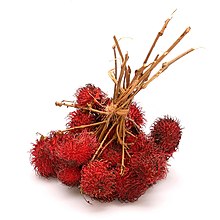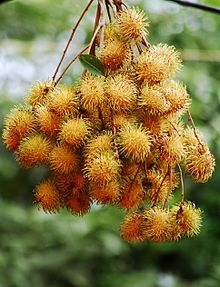The rambutan (taxonomic name: Nephelium lappaceum) is a medium-sized tropical tree in the family Sapindaceae, and the fruit of this tree. It is native to Indonesia, Malaysia, The Philippines, Sri Lanka and elsewhere in Southeast Asia, although its precise natural distribution is unknown. It is closely related to several other edible tropical fruits including the Lychee, Longan, and Mamoncillo. It is believed to be native to the Malay Archipelago, from where it spread westwards to Thailand, Burma, Sri Lanka and India; eastwards to Vietnam, the Philippines and Indonesia.
The name rambutan is from the Malay word rambutan, which literally means hairy caused by the 'hair' that covers this fruit, and is in general use in Malay and Filipino. There is a second species regularly for sale at Costa Rican markets which is known as "wild" rambutan. It is a little smaller than the usual red variety and is colored yellow. The outer skin is peeled exposing the fleshy fruit inside which is then eaten. It is sweet, sour and slightly grape like and gummy to the taste. In Costa Rican Spanish it is known as mamón chino (translated "Chinese sucker") due to the likeness of the edible part with Melicoccus bijugatus and its Asian origin.
Rambutan are non-climacteric fruit - that is, they refuse to ripen unless on the tree. Local rambutan has various type. The fruits are in red, pink and yellow color. The taste are also different, from sweet up to sour one. Rambutan fruits normally can split the flesh and the seeds easily when eaten. There are also rambutan fruits which never allow the flesh leaving the seeds. This type of rambutan is a bit smaller in size, yet sweet and delicious in taste. Some local people will swallow the flesh together with the seeds when eating it. They are very good for rambutan jams.

It is an evergreen tree growing to a height of 12–20 m and in Malaysia it is considered as a local timber woods. The leaves are alternate, 10–30 cm long, pinnate, with 3-11 leaflets, each leaflet 5–15 cm wide and 3-10 cm broad, with an entire margin. The flowers are small, 2.5–5 mm, apetalous, discoidal, and borne in erect terminal panicles 15–30 cm wide.
Rambutan trees are either male (producing only staminate flowers and, hence, produce no fruit), female (producing flowers that are only functionally female), or hermaphroditic (producing flowers that are female with a small percentage of male flowers).
The fruit is a round to oval drupe 3–6 cm (rarely to 8 cm) tall and 3-4 cm broad, borne in a loose pendant cluster of 10-20 together. The leathery skin is reddish (rarely orange or yellow), and covered with fleshy pliable spines, hence the name rambutan, derived from the Malay word rambut which means hairs. The fruit flesh is translucent, whitish or very pale pink, with a sweet, mildly acidic flavour. The single seed is glossy brown, 1–1.3 cm, with a white basal scar. The seed is soft and crunchy. They are mildly poisonous when raw, but may be cooked and eaten.
Rambutan is a popular garden fruit tree and propagated commercially in small orchards. It is one of the best known fruits of Southeast Asia and is also widely cultivated elsewhere in the tropics including Africa, the Caribbean islands, Costa Rica, India, Indonesia, the Philippines, and Sri Lanka. Thailand is the largest producer from Surat Thani Province Thailand. Rambutan production is increasing in Australia and, in 1997, was one of the top three tropical fruits produced in Hawaii. It is also produced in Ecuador where it is known as "achotillo."
The fruit are usually sold fresh, used in making jams and jellies, or canned. Evergreen rambutan trees with their abundant coloured fruit make beautiful landscape specimens.
Rambutan found in markets that is harvested as picked from their stems, is commonly ridden with insects, prone to rot, and of relatively low viability per bunch sold, especially compared to other fruits. The best quality rambutan is generally that which is harvested still attached to the branch. It is less susceptible to rot, damage, and pests, and remains fresh for a much longer time than rambutan that has been picked from the branch.
Another indicator of quality is the ease of detachment of the flesh from the seed. An easily detachable flesh normally will have bits of the woody seed coating. Thus, it is a common Malay wisdom to not eat too much rambutan when one has a cough.
Rambutan is adapted to warm tropical climates, around 22–30°, and is sensitive to temperatures below 10°C. It is grown commercially within 12–15° of the equator. The tree grows well on heights up to 500 meters (1,600 ft) above sea-level and does best in deep soil; clay loam or sandy loam rich in organic matter, and thrive on hilly terrain as they require good drainage. Rambutan is propagated by grafting, air-layering, and budding; the latter is most common as trees grown from seed often produce sour fruit. Budded trees may fruit after 2–3 years with optimum production occurring after 8–10 years. Trees grown from seed bear after 5–6 years.
The aril is attached to the seed in some commercial cultivators, but "freestone" cultivators are available and in high demand. There is usually a single light brown seed which is high in certain fats and oils (primarily oleic acid and arachidic acid) valuable to industry, and used in cooking and the manufacture of soap. Rambutan roots, bark, and leaves have various uses in medicine and in the production of dyes.
Rambutan trees bear fruit twice annually, once in late fall and early winter with a shorter season in late spring and early summer. The fragile nutritious fruit must ripen on the tree, then they are harvested over a four to seven week period. The fresh fruit are easily bruised and have a limited shelf life. An average tree may produce 5,000-6,000 or more fruit (60–70 kg or 130-155 lb per tree). Yields begin at 1.2 tonnes per hectare (0.5 tons/acre) in young orchards and may reach 20 tonnes per hectare (8 tons per acre) on mature trees. In Hawaii, 24 of 38 cultivated hectares (60 of 95 acres) were harvested producing 120 tonnes of fruit in 1997. It has been suggested that yields could be increased via improved orchard management, including pollination, and by planting high yielding compact cultivators.
Most commercial cultivators are hermaphroditic (producing flowers that are female with a small percentage of male flowers); cultivators that produce only functionally female flowers require the presence of male trees. Male trees are seldom found as vegetative selection has favored hermaphroditic clones that produce a high proportion of functionally female flowers and a much lower number of flowers that produce pollen. There are over 3000 greenish-white flowers in male panicles, each with 5-7 anthers and a non-functional ovary. Male flowers have yellow nectarines and 5-7 stamens. There are about 500 greenish-yellow flowers in each hermaphroditic panicle. Each flower has six anthers, usually a bi-lobed stigma, and one ovule in each of its two sections (locules). The flowers are receptive for about one day but may persist if pollinators are excluded.
In Malaysia, rambutan flowers from March to July and again between July and November, usually in response to rain following a dry period. Flowering periods differ for other localities. Most, but not all, flowers open early in the day. Up to 100 flowers in each female panicle may be open each day during peak bloom. Initial fruit set may approach 25% but a high level of abortion contributes to a much lower level of production at harvest (1 to 3%). The fruit matures 15–18 weeks after flowering.
Both male and female flowers are faintly sweet scented and have functional nectaries at the ovary base. Female flowers produce 2-3 times more nectar than male flowers. Nectar sugar concentration ranges between 18-47% and is similar between the flower types. Rambutan is an important nectar source for bees in Malaysia.
Cross-pollination is a necessity because pollen is absent in most functionally female flowers. Although apomixis may occur in some cultivators, research has shown that rambutan, like lychee, is dependent upon insects for pollination. In Malaysia, where only about one percent of the female flowers set fruit, research revealed that no fruit is set on bagged flowers while hand pollination resulted in 13 percent fruit set. These studies further suggest that pollinators may maintain a fidelity to either male or hermaphroditic flowers (trees), thus limiting pollination and fruit set under natural conditions where crossing between male and female flowers is required.









No comments:
Post a Comment